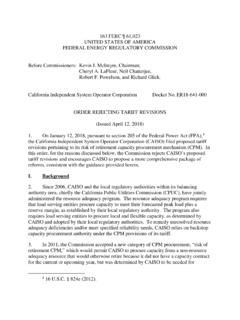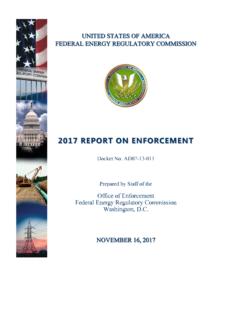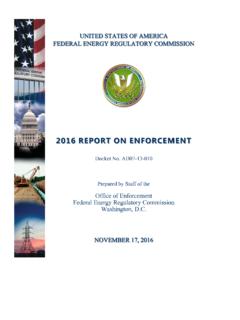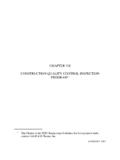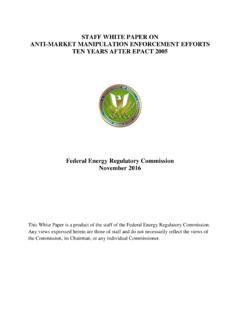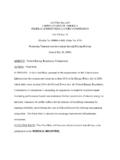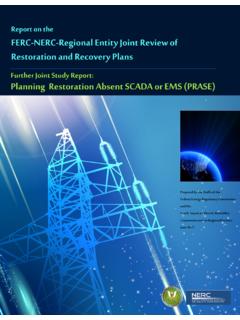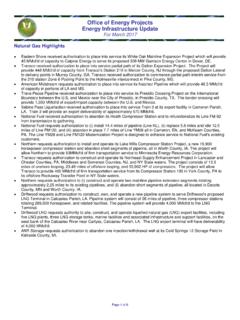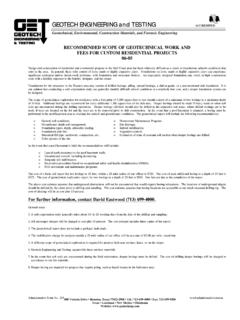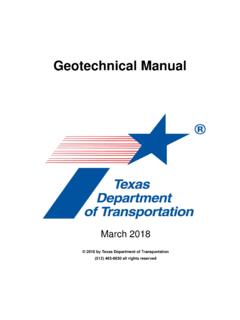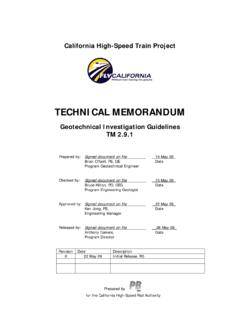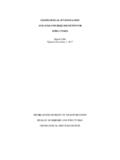Transcription of CHAPTER V GEOTECHNICAL INVESTIGATIONS AND STUDIES
1 CHAPTER V. GEOTECHNICAL INVESTIGATIONS AND STUDIES . APRIL 1991. CHAPTER V. GEOTECHNICAL INVESTIGATIONS AND STUDIES . (Dams, Dam Sites or Appurtenant Structures). 5-0 Contents Title Page 5-1 General .. 5-1. 5-2 Purpose and Scope .. 5-1. 5-3 References .. 5-2. 5-4 Sources of Pre-existing Data and Information .. 5-2. 5-5 Need for Supplemental Information .. 5-4. 5-6 Geological investigation and Review .. 5-5. 5-7 Intensity of INVESTIGATIONS .. 5-5. Preliminary INVESTIGATIONS .. 5-6. Initial Design INVESTIGATIONS .. 5-6. Final Design INVESTIGATIONS .. 5-7. 5-8 Methods of INVESTIGATIONS .. 5-7. Constructed Projects .. 5-7. Unconstructed Projects .. 5-8. Types of Exploration .. 5-8. Geologic Reconnaissance and Mapping .. 5-8. Borings .. 5-8. Special Excavations .. 5-8. Geophysical .. 5-8.
2 Location of Explorations .. 5-9. Laboratory Tests .. 5-9. Field Tests .. 5-9. 5-i 5-0 Contents (Cont.). Title Page 5-9 Instrumentation and Monitoring .. 5-10. General .. 5-10. GEOTECHNICAL Instrumentation .. 5-12. 5-10 Special Geologic Hazard STUDIES .. 5-13. Volcanic Hazards .. 5-13. Seismic Hazards .. 5-14. 5-11 Submittal of GEOTECHNICAL Report .. 5-15. 5-12 Summary .. 5-17. 5-13 References .. 5-17. 5-14 Appendices .. 5-19. Appendix V-A Types of Exploration Appendix V-B Field Permeability Tests Appendix V-C FERC Parameters for Developing Stability Analyses List of Tables 5-1 Causes of Deficient Behavior, Means of Detection .. 5-11. 5-2 Inventory of GEOTECHNICAL Instruments .. 5-13. 5-ii CHAPTER V. GEOTECHNICAL INVESTIGATIONS AND STUDIES . (Dams, Dam Sites, or Appurtenant Structures).
3 5-1 GENERAL. An adequate assessment of site geologic and GEOTECHNICAL conditions is one of the most important aspects of a dam safety evaluation. Evaluation of the safety of either a new or an existing dam requires, among other things, that its foundation has been adequately examined, explored, and investigated so that it is as fully understood as possible. Foundation explorations should be directed towards obtaining only such information as may be important to an evaluation of the dam. The exploration program should identify the factors that critically affect the safe performance of the dam, and not develop extraneous information. The following sections of this CHAPTER briefly identify the principal methods commonly employed in foundation INVESTIGATIONS , and are intended to suggest approaches and scopes of INVESTIGATIONS which, when properly implemented, should comply with FERC requirements and expectations.
4 It is emphasized that, because of the almost infinite variety of geologic conditions from site to site , it would be unreasonable and impractical to attempt to set forth in these Guidelines specific investigation programs. While this CHAPTER is principally directed toward dams and dam sites, the types of INVESTIGATIONS and STUDIES discussed are also applicable to other water retention structures and appurtenant structures of hydropower projects. 5-2 PURPOSE AND SCOPE. The purpose of this CHAPTER is to present guidelines for use by FERC staff for determining the appropriateness and level of GEOTECHNICAL INVESTIGATIONS and STUDIES for dams, water retention structures and other appurtenances. Reports on such INVESTIGATIONS and STUDIES must be included in the technical exhibits supporting; (a) applications for license, (b) final design reports, and (c) Part 12 reports (FERC.)
5 Regulations, 18 Part 12) by independent consultants, when such reports have not been previously submitted or referenced. The scope of this CHAPTER is intended to outline the desirable quantity and quality of those INVESTIGATIONS required to support design or evaluation conclusions. It is fully recognized that the specific investigation programs and STUDIES for individual projects cannot realistically be standardized, and will vary widely according to site conditions, type of dam, hazard classification, and design phase. 5-3 REFERENCES. Selection of field investigation procedures, and use of data evaluation procedures supporting geologic or GEOTECHNICAL reports, are acknowledged to be best guided by criteria and procedures available in qualified literature, as well as by proven local practice.
6 Reliable sources include publications and manuals authored by the Corps of Engineers, Bureau of Reclamation, American Society of Civil Engineers, Committee on Large Dams, and other widely recognized engineering organizations. In each particular case, variations based on good judgment and experience are encouraged and differing approaches of scope and detail between government and private practice are realistically inevitable. Selected references are listed in Section 5-13. 5-4 SOURCES OF PRE-EXISTING DATA AND INFORMATION. The GEOTECHNICAL information and data presented in a licensee's or applicant's design report and in Independent Consultant's (Part 12) report, should incorporate references, where applicable to available FERC reports. The following reports may be useful: Operation Inspection Reports Construction Inspection Reports Independent Consultants' Safety Inspection Reports Other Inspection and/or Special Reports on existing dams or sites that are available One or more of the above listed reports can be expected to be available for licensed projects.
7 If a license has not previously been issued, the FERC staff engineer performing the review may have available the Prelicense Inspection Report prepared by the responsible FERC regional office. For existing dams, geologic and GEOTECHNICAL data may be available from the facility owner, previous owners, state or local agencies if the facility is a publicly owned project, and from the state agency responsible for dam safety. Also, geological information may be available from Corps of Engineers Phase I Inspection Reports of public or private entities having impounding structures upstream or downstream of the facility. For proposed dams, the source of GEOTECHNICAL information will generally be the licensee and/or the applicant's consultants and engineers. For all proposed dams, the applicant will be required to provide those data necessary to evaluate whether the foundation of the proposed structure is adequate to safely construct the structure proposed for that site .
8 Data to be made available should include, where applicable: 5-2. Logs of borings, test pits, and exploratory trenches site geologic maps and reports site seismicity reports site geophysical reports Materials exploration and testing reports Reservoir rim conditions Reports and papers published by Geological Societies and Departments in their Bulletins Correspondence that may highlight geological changes or problems in the foundation Design drawings and specifications for foundation excavation and support Local landslide history Inspection records Maintenance records Aerial photography Seepage history Licensee's reports Construction photographs Concrete materials and mix design As built drawings Instrumentation and monitoring data 5-5 NEED FOR SUPPLEMENTAL INFORMATION. 5-3. The preferred approach for assessing the adequacy of dam foundations should be to minimize the use of general assumptions as to foundation conditions and strength parameters.
9 The objective of reviewing existing data is self-evident. site -specific information and data-based analyses should be the prevalent basis for judgments on dam safety. If potentially hazardous foundation conditions are believed or determined to exist, and the existing data are insufficient to resolve the problem, it will be necessary to conduct supplemental INVESTIGATIONS and analyses, or develop additional information to complete the evaluation. Appendix V-C provides step-by-step procedures for developing the parameters needed in a stability analysis. The supplemental information will usually involve additional explorations and testing, materials testing and seismic information. Typical conditions that would require additional foundation explorations for existing dams are suggested below: Significant cracking, settlement or sloughing of dams or related nearby structures.
10 Increase in settlement rates or indications of downstream movement. Uncontrolled seepage conditions under, through, and around foundations or abutments, and at the toe area of any water retention structures. Sudden or steady increase in observed seepage. Credible foundation data is insufficient to support stability analysis. Unexplained high or rapid rise in piezometric pressures either in the foundation or abutment material or within an embankment structure. Highly fractured, jointed rock. Rock formations that are known to be susceptible to seepage problems, solution activity or erodible material. Rock formations that are conducive to weak seams or planes with low strength characteristics and adverse orientation ( downstream dip). Use of assumed high shear-strength parameters in a stability analysis that are not justified or supported.
